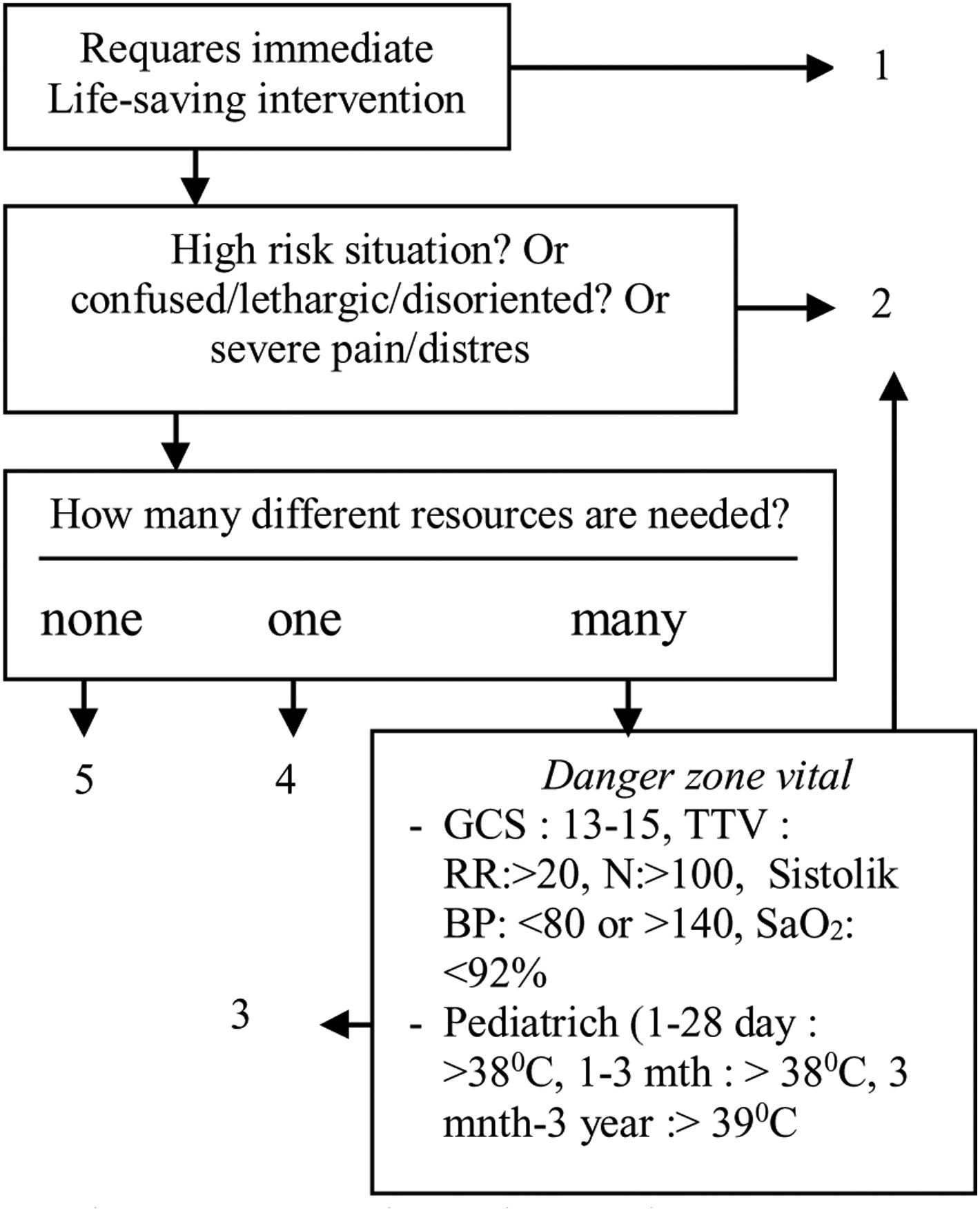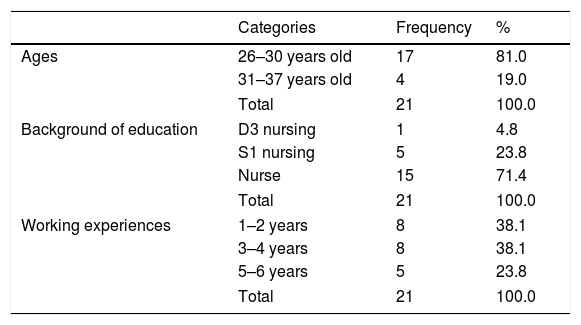Triage is basically a categorization process to prioritize various treatments for patients based on the types of disease, severity, prognosis and resource availability. However, the term triage is more appropriate to be used in the context of natural disaster or mass casualties. Within the context of emergency situation in emergency department, the term triage refers to a method used to assess the severity of patients’ condition, determine the level of priority, and mobilize the patients to the suitable care unit. ESI is a new concept of triage using five scales in classifying the patients in emergency department. The real implementation of this concept demands nurses have to immediately make assessment about patients’ condition right away, besides they must give their final decision, whether to move the patients to the ward or to let them leave the hospital.
MethodThis research was done using Pretest–Posttest one Group Design, involving 21 nurses in the Emergency Department of RSUD Pariaman as research respondents. Before respondents were introduced to ESI method, their basic skills had been previously evaluated, which evaluation results were compared to the after-treatment results. A set of questionnaires consisting of 10 cases were used as research instrument.
ResultsThe result of this research showed that the value or rank difference between common triage and ESI triage categorization was positive (N). The mean rank was found at 11.00, while the sum of positive rank was 231.0 as shown in Asymp. Sig. (2-tailed) score of 0.00 lower than 0.05. Therefore, the null hypothesis was rejected.
ConclusionsThere were differences in triage categorization before and after respondents were introduced to ESI method.
Emergency Medical Service (EMS) has been said as the most crucial key entrance to a hospital. The number of patients referred or self-referring to the EMS is beyond precise prediction, to trigger a patient density and get the all the patients frustrated. In addition, such occurrence may also give impact to the patients’ privacy and safety, which somehow brings frustration to the EMS employees.1
It is of necessity to find out an apt solution to deal with it, commonly named as triage plan. The implementation of the triage plan could be performed by means of a couple of methods of which principles refer to airway, breathing, and circulation or primary survey. To gain more accurate results of primary survey, secondary survey is supposed to be performed.
Most of Indonesian hospitals are still making use of classical triage system, to create a quick category with such colors as black, red, yellow, and green, which all were adapted from the triage system for disaster. This kind of system is deemed inappropriate to implement at the EMS of modern hospitals on the basis of evidence-based medicine. As the consequence, there exist some referral evidence-based triage systems, called as ESI (Emergency Severity Index) originated from the United States.2
ESI constitutes a triage concept to refer to 5 main scales in classifying the patients. After focusing on each of the levels, the patients will soon be referred by the nurses to get an immediate intervention based on the determined level (Figure 1).
ESI algorithm to determine triage level.3,9
In a study entitled “Validation of the Emergency Severity Index (ESI) in Self Referred patients in a European Emergency Department”, there was illustrated a validity test for ESI algorithm on the patients referred and self-referring to educational and non-educational hospitals in Europe. In the study, as many as 42,000 patients from numerous hospitals were recruited as the sample of the study. In the first day, the nurses and doctors were taught about how perform ESI triage. As a result, the category of ESI triage used in performance had shown its reliability in examining seriousness level of disease the patients were suffering from.4
RSUD Pariaman (Public State Hospital of Pariaman) is one of the referral hospitals with large EMS room. However, based on the result of observation and interview with the Head of EMS of RSUD Pariaman, it was illustrated that the triage method they performed was still classical and had yet to fulfill the standards of procedure .5
The classical method, in this context, refers to a process of patient classification by determining level of immediateness by means of several colors, such as black, red, yellow, and green, which are all adapted from the triage system for disaster. A number of assumptions contend that this kind of system is not really appropriate to be implemented at the EMS of modern hospitals on the basis of evidence-based medicine. On the other hands, ESI would be much easier to be implemented in Indonesia due to inexistence of specific limit of time which has to be strictly determined for each the level. Additionally, ESI does not merely consider diagnosis for the sake of determining level of triage. For this reason, the research was of good interest to conduct a research about ESI method for triage categorization.
MethodPre-test and Post-test One Group design with t dependent analysis was stipulated as the research design.6 In this current research, there was a group of respondents, to be given an understanding on ESI method by means of algorithm. To measure, questionnaire was used, to include 10 cases. Before given the understanding, their prior understanding was measured as a referral information. Later, after they received the holistic understanding, they were going to re-measured, by using the same measurement.
ResultAlluding to the result of the result on 21 nurse respondents assigned at the EMS of RSUD Pariaman as shown in Tables 1 and 2.
Based on abovementioned table, it had been evidently identified that the difference between the negative and positive ranks for the triage categorization in the hospital by means of ESI method signified positive (N). The mean rank signified 11.00, while the sum of rank constituted 231.0. In conclusion, based on the Asymp. Sig. (2-tailed), it was evident that 0.00<0.05; thus, 0 hypothesis was rejected. It could be said that there was a difference of triage categorization before and after given the understanding on ESI method.
DiscussionResponse time at the EMS constituted a quality indicator for hospital service. The time the patients need in order to receive an immediate medical treatment, from the doctors or nurses, since their arrival at the EMS constituted 5min long. The difference in categorization would affect the service immediateness and given intervention.
The ability for quick diagnosing and response would save the patients’ life from their illness or injuries. The nurses were responsible for determining the service priority. In addition, immediate service at the EMS and priority setting were also determined by several factors, such as number of visits, nurses’ skills, tools and other assistive components.
Based on the research of Sumardiko,2 the real concept of ESI triage was much more applicative to implement since the assessment did not take too long time. In addition, the ease of interventive referral based on the ESI classification had been elaborated at the guideline of ESI triage. Another benefit of ESI triage was to create an immediate identification for the patients with the need of medical treatment by giving a quick response after determining the level.
Triage was performed by the experienced nurses in the room of triage. The patients would be fast treated by the professional nurses in the room of it. The quick and accurate triage performance required the qualified nurses with a good background of education, experience, and great qualification.7
In general, the patients had to receive an initial treatment before getting categorized in what level they should be belong to. In other words, the nurses had to know the condition or situation that may occur generated by the diseases the patients were suffering from. Further, the nurses were to measure and make a judgment on the patients’ condition, whether or not they should receive a further treatment (observation), repatriation, or migration to another medical room.
This was in line with the theory of nursing for emergency situation proposed by Orland, which pinpointed more on the quick response or immediate action from the nurses upon the patients when the arrive at the EMS.8
ConclusionThe working procedure of ESI application had been guided by means of algorithm, which, further, was referred to the expected intervention. The triage categorization had been performed on the 10 cases given. The research, moreover, showed that there was a significance of triage categorization before and after given an understanding about the ESI method.
A gratitude and praise be upon Director of Nursing Academy of Baiturrahmahdan LPPM Akper Baiturrahmah who had facilitated and supported; the editor who had checked and reviewed the research; the students involved in the research; RSUD Pariaman for the hospitability during the research; and all the parties who supported. This research was fully funded by DIKTI for academic budget 2018 and then all partied involved in this research.
Peer-review of abstracts of the articles is under the responsibility of the Scientific Committee of Riau International Nursing Conference 2018. Full-text and the content of it is under responsibility of authors of the article.










